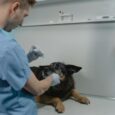Life with pets is always fun. That’s precisely why we barely notice the time move past us so fast. We proceed with our days with fun and new encounters with our furry friends, and the next thing we know, they’re in their golden years. As a pet owner, it’s crucial that you understand the symptoms of aging so that you could better take care of them before the end of their own lives. If you’ve had your pets about, here are a few helpful suggestions to be sure to provide them the quality of attention they need as they grow old with you.
Signs Your Pet is Aging
As to how you have been when they were in their younger years, you need to correct your attention and strategy in caring for them once they become old. Take a glimpse of a few of the symptoms of aging and learn how to pick up cues as you continue to grow old with them.
Vision Issues
You might think they’ve become clumsy with time; however, they might have vision issues associated with aging. Some animals develop eye cloudiness, cataracts, or other eye ailments as they age. Luckily, the majority of them are treatable, mainly if diagnosed early. The significance of bringing them to their routine puppy check up and evaluations can make this possible for you. This is vital for early therapy and vision loss prevention.
Halitosis or Bad Breath
It’s not difficult to believe that their bad breath might result from their diet or something that they ate, but there’s even more to this than that. Most of the time, halitosis suggests problems like disease, gum disease, tooth decay, or other dental problems. These circumstances can be prevented through routine dental appointments and cautionary measures to be certain they maintain their teeth intact and in great form.
Slow Movements
Occasionally, you might think of these as lazy, but an aging puppy may develop potential leg, joint, and circulation issues. If you observe that your pet is less active than normal, have them assessed for possible health problems like arthritis. This is a frequent requirement for older dogs, which might lead to pain and might restrict their movement over time.
Weight Changes, Incontinence, or Unusual Bumps
When pets get to the age of ten, they become vulnerable to growing harmful health issues. If you observe an irregular lump or bulge on your pet, be certain that you get them pet vaccinations and have them assessed for early identification of the condition. This also applies to sudden weight fluctuations or the inability to clinic home training or potty training. Old age contributes to the deterioration of physiological functions, so it is helpful to consult with a geriatric vet for assistance and advice in proper geriatric care.
Conclusion
Aging is a stage that’s every bit as difficult for pets. When they grow old and reach their golden years, their movement becomes limited, and their immune system is not as effective in fighting diseases as when they’re younger. Knowing the signs as soon as your pets are aging will help you adjust better for their physical, psychological, and emotional demands. Be certain that you remain alert and careful as they grow older to be certain to provide them the quality of life that they deserve.





